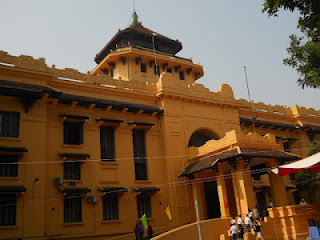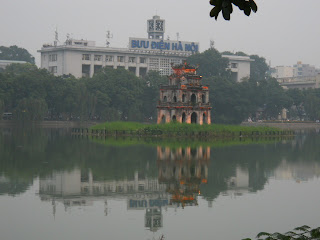 Hanoi girls dressed in ao dai at Ly Thai To Park which is directly opposite the State Bank of Vietnam Building.
Hanoi girls dressed in ao dai at Ly Thai To Park which is directly opposite the State Bank of Vietnam Building.The áo dài is a Vietnamese national costume,mostly made of silk started to be worn during the 18th century in the judicial court.
The word is pronounced ow zai in the North and ow yai in the South of the country.
During the Tết New Year and many other occasions, Vietnamese men may wear an áo gấm (brocade robe), a version of the ao dai made of thicker fabric.

Slender and long haired Hanoi student girls dressed in light pastel flowery 'ao dai'.
The 1992 films Indochine and The Lover inspired worldwide interest in Vietnamese fashion, with several international fashion houses offering 'ao dai' collections.
In 1995, an 'ao dai' worn by Ms. Truong Quynh Mai was chosen as ‘Best National Costume’ at the Miss International Pageant in Tokyo, triggering an ‘ao dai craze’ that lasted for several years.
Academic commentary on the ao dai emphasizes the way the dress ties feminine beauty to Vietnamese nationalism, especially in the form of "Miss Ao Dai" pageants, popular both among overseas Vietnamese and in Vietnam itself .
"Ao dai" is one of the few Vietnamese words that appear in English-language dictionaries.
A giant monument of Emperor Ly Thai To was behind this fountain in Ly Thai To Statue and Park.
He was the founder of the Lý Dynasty and also the founder of Hanoi City reigning from 1009 to 1028 AD.
In fact the Lý Dynasty ruled Vietnam for 216 years having nine emperors taking the throne.
The State Bank of Vietnam (Vietnamese: Ngân hàng Nhà nước Việt Nam) is the central bank of Vietnam.
After the fall of Saigon, the two Vietnams were united but not until July 1976 did the two countries’ administrations and institutions unite.
In July 1976, the National Bank of Vietnam (the central bank of Republic of Vietnam) was merged into the State Bank of Vietnam.
The Vietnamese đồng (VND) has been the currency of Vietnam since May 3, 1978 and was Issued by the State Bank of Vietnam, It is currently ranks as the second least valuable currency in terms of exchange rate.

State Guesthouse is a government guesthouse specifically used for news briefing to foreign dignitaries.
Hanoi Opera building was erected by the French colonial administration between 1901 and 1911.
It was modeled on the Palais Garnier, the older of Paris's two opera houses, and is considered to be one of the architectural landmarks of Hanoi.
The luxurious French colonial styled Hotel Sofitel Legend Metropole located along Ngo Nguyen Street,Hoan Kiem District in Hanoi.
Just married Vietnamese couple.

Sweet lovely Vietnamese girl.
Pretty Vietnamese girls in their best outfit,the 'ao dai' with their luxurious silky long hair.
This means that hair saloons and shampoo companies can do a roaring business here in Vietnam.

Cafe Giai Khat at No:23 Le Thanh Tong Street is one traditional Vietnamese restaurant offering authentic local cuisines.

Vietnamese boy after lunch at Cafe Giai Khat.

The National Museum of Vietnamese History (Vietnamese: Viện Bảo tàng Lịch sử Quoc Gia Việt Nam) is located So 1,Trang Tien, the Hoan Kiem district of Hanoi, Vietnam.
The building used to be the museum of the Far East Research Institute under French colonial rule (École française d'Extrême-Orient EFEO).
Today, it is a museum showcasing Vietnam's history with very large displays covering every period.
It is housed in a colonial French building which was completed in 1932.
The building, designed by the architect Ernest Hébrard, is considered a successful blend of French colonial and traditional Vietnamese architecture, called Indochina architecture.
Hebrard created double walls and balconies for a natural ventilation system and protection from sunshine.
Located at the corner of Tran Khanh Du mainroad with Trang Tien
Public Bus No 34 stop at Trang Tien while Bus number 03,24,42,43,204,207 and 208 stop at Trang khanh Du.
If you are staying around the Old Quarters,it's just a short distance walk.

Across the road from the National Museum is the Vietnamese Revolution Museum(Bảo tàng Cách mạng Việt Nam) at 25,Tong Dan Road off Tran Quang Khai.
Weekdays opening hours:08:00 -11:30 and 13:30hr -16:15hr.

Vietcombank headoffice located along Trần Quang Khải, Hoàn Kiếm, Hà Nội.
Also known as The Bank for Foreign Trade of Vietnam (Swift:BFTV VNVX),it was established on April 1st, 1963 as a State-owned Commercial Bank.
The State of Vietnam owns 1,199,666,918 shares or 90.72%
General public shareholding consisted of 122,704,534 shares or 9.28%
Total paid up as at financial year ended 31 December 2010 is 1,322,371,452 shares with a par value of 10,000VND per share.
It was the first commercial bank in Vietnam to deal with foreign currencies and has the largest market share in the interbank forex trading.
Also the largest agent for card payment in Vietnam: for Visa, American Express, MasterCard, and JCB.
An advertisement by the Kings' Valley Corporation promoting Kings’ Island Golf Club located 36 km. west of Hanoi, and 45 km. from Noi Bai International Airport.
The club is located in the Kings’ Valley on 350 hectares along the shores of Dong Mo Lake where access to the course is by boat.
This golf course was designed by Pacific Coast Design Pty. Ltd. Based in Melbourne, Australia. Pacific Coast has been involved in site planning & golf design for over 18 years and has completed major projects in India, Malaysia, China, Thailand & Australia.
Membership fees starts from 1.760.000.000 VND
Hanoi Office is 5th floor, 18 Ly Thuong Kiet street, Hoan Kiem district, Hanoi.
Tel/ Fax : 04. 39448690/91, 04.3715.3458/ 3715.3455
BIDV (Bank for Investment and Development of Vietnam) Tower, located at No.194 Tran Quang Khai Street in Hoan Kiem District, Hanoi is a brand new Grade A office building of 25 levels with 2 basements and 1 mezzanine basement.
 The total gross floor area is approximately 35,000 sq m .
The total gross floor area is approximately 35,000 sq m .This property is being managed by the Savills Group heaquartered in England. Savills Vietnam is the longest running and largest property consultancy in Vietnam, with a continuous presence since 1995 having employed over 750 employees nationwide.
















































